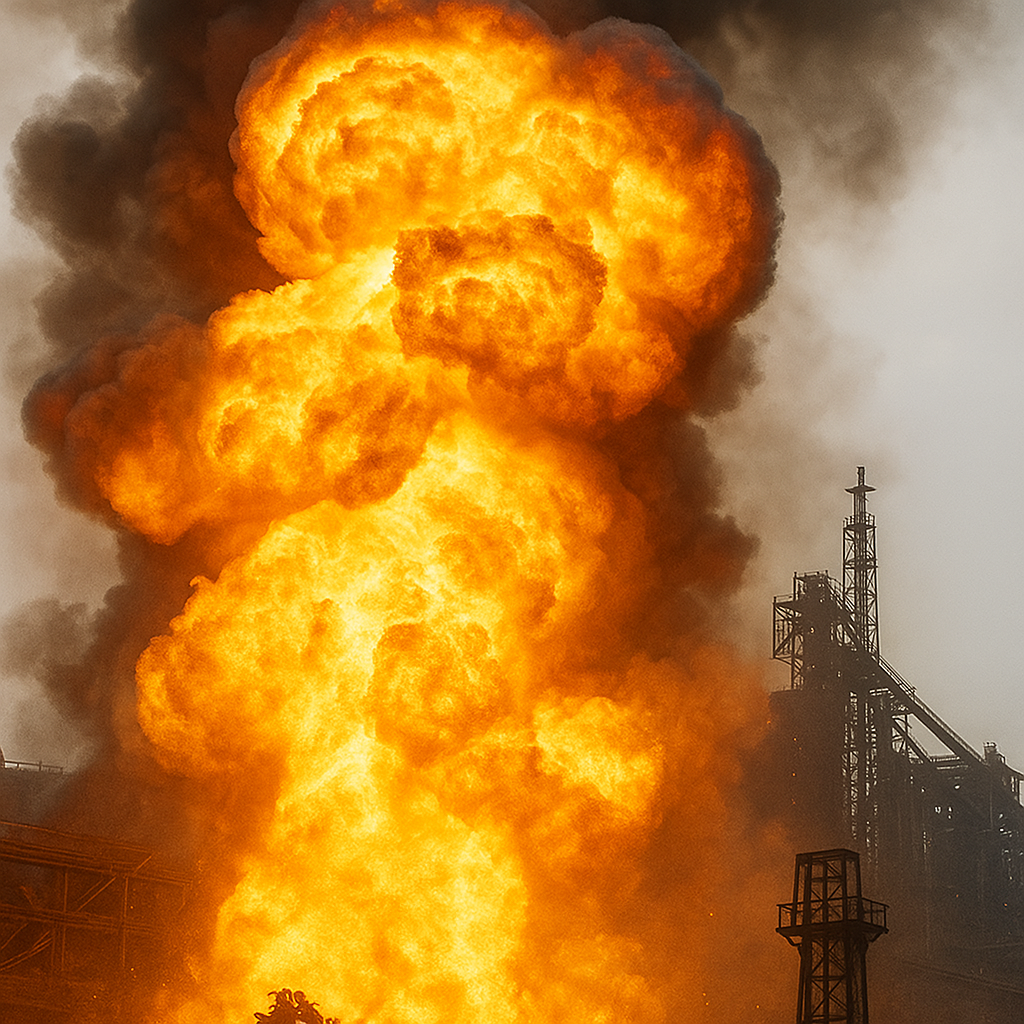Industrial Explosion Lawsuits: Your Complete Guide to Legal Rights and Compensation
How to File an Industrial Explosion Lawsuit
Workplace exposure to volatile chemicals, electrical currents, extreme heat and explosive materials place many American workers at an industrial risk, where burn injuries can occur and cause serious and permanent damage. According to the Bureau of Labor Statistics (BLS), more than 16,000 industrial injuries due to thermal burns were reported during 2013.
Industrial explosions are among the most catastrophic workplace accidents, often causing devastating injuries, property destruction, and even loss of life. These incidents can happen at chemical plants, steel mills, oil refineries, manufacturing facilities, and warehouses handling flammable materials. When negligence, unsafe working conditions, or defective equipment leads to such disasters, victims and their families may have the right to file an industrial explosion lawsuit.
Understanding Industrial Explosions and Their Causes
Industrial explosions occur when combustible gases, dust, or chemicals ignite under certain conditions—often due to mechanical failure, safety violations, or human error. These events can trigger chain reactions, secondary fires, and structural collapses.
While explosions can happen without warning, investigations often reveal that they were preventable. In many cases, companies fail to adhere to OSHA safety standards or ignore known hazards.
Common causes of industrial explosions include:
-
Improper storage of flammable chemicals.
-
Defective machinery or equipment.
-
Lack of ventilation in enclosed work areas.
-
Welding or cutting near combustible materials.
-
Electrical malfunctions or overloaded circuits.
-
Failure to follow safety protocols during maintenance.
Legal Basis for an Industrial Explosion Lawsuit
Victims of industrial explosions may pursue lawsuits under several legal theories, depending on the circumstances. A case could involve:
-
Negligence Claims: Proving the responsible party failed to take reasonable steps to prevent the explosion.
-
Product Liability: Holding manufacturers accountable for defective machinery, tools, or safety equipment.
-
Premises Liability: When a property owner fails to maintain a safe environment for workers or visitors.
-
Wrongful Death: Filed by families of those killed in the explosion.
An attorney will typically gather accident reports, OSHA findings, maintenance logs, and witness testimony to establish liability.
Step-by-Step Process of Filing an Industrial Explosion Lawsuit
-
Seek Medical Treatment Immediately – Your health comes first, and medical records will serve as crucial evidence.
-
Preserve Evidence – Photos, videos, damaged equipment, and witness statements should be documented early.
-
Report the Incident – Notify OSHA, local authorities, and your employer promptly.
-
Contact an Experienced Attorney – A lawyer specializing in industrial accidents can launch an investigation quickly.
-
File a Claim or Lawsuit – Your attorney will determine whether to begin with an insurance claim or file directly in court.
-
Negotiate or Proceed to Trial – Many cases settle, but some require litigation to secure fair compensation.

Proving Negligence in Industrial Explosion Cases
Hundreds of workers die each year as a result of injuries sustained in an industrial burn injury accidents, fires and workplace explosions. Millions of individual burn incidents occur in work environments each yea, most minor, but others which require hospital visits, and they can be deadly. Many industrial burn injury accidents are the result of the following:
- OSHA safety violations
- Negligent employers
- Failure to provide safety training
- Failure to protective equipment
- Worker Fatigue
- Improper storage of flammable materials
- Combustible Dust Explosion
Joe Lyon is an experienced workplace injury attorney and OSHA safety violation lawyer accepting industrial burn injury cases nationwide.
Types of Industrial Burn Injury
Workers that suffer from severe burns in work-related accidents usually come into contact with hot steam, open flames, open electrical currents, caustic chemicals or other heated industrial materials or machinery. Common types of industrial burn injury include:
- Thermal Burns—caused by steam or hot liquid from machinery, equipment, vehicles or piping.
- Electrical Burns—caused by electrical currents traveling through the body, resulting in burn injuries. Workers and employers are urged to identify and mark live wires, and to avoid contact with water while working with electrical currents. Protective equipment should be provided, per OSHA safety standards.
- Chemical Burns—caused by contact with hazardous industrial chemicals. Chemical splashes and spills can lead to serious industrial chemical burns to workers. Inhalation injuries are also a risk, causing burns to workers nasal passages, throat and esophagus.
Severity of Industrial Burn Injury
- First-degree burns cause some skin damage but only affect the top layer of the skin.
- Second-degree burns extends beyond the top layer of skin and can cause blistering and pain.
- Third-degree burns affect the epidermis and the dermis, as well as underlying tissue.
- Fourth-degree burns can affect muscle, tendons and bone. The burns may require amputation.
Employer Negligence & Workplace Accidents
If workplace explosions and industrial burn injury accidents are the result of improper safety or ineffective training, an employer may be liable for the injury and damages caused. Occupations and professions at particular risk may include the following:
- Welding
- Offshore drilling
- Auto mechanic
- Steel worker
- Plumber
- Chemical worker
- Construction
- Fracking
- Manufacturing
OSHA Safety Standards for Preventing Explosions
-
Proper labeling and storage of hazardous materials.
-
Routine equipment inspections and maintenance.
-
Adequate ventilation systems in enclosed workspaces.
-
Explosion-proof electrical installations in high-risk areas.
-
Mandatory safety training for employees.
Steps to Take After an Industrial Explosion
-
Get to a safe location immediately.
-
Call emergency services and report the explosion.
-
Seek medical attention even if injuries seem minor.
-
Document the scene with photos or videos.
-
Collect contact information from witnesses.
-
Consult with an attorney before speaking with insurance companies.
CONTACT THE LYON FIRM TODAY
ABOUT THE LYON FIRM
Joseph Lyon has 17 years of experience representing individuals in complex litigation matters. He has represented individuals in every state against many of the largest companies in the world.
The Firm focuses on single-event civil cases and class actions involving corporate neglect & fraud, toxic exposure, product defects & recalls, medical malpractice, and invasion of privacy.
NO COST UNLESS WE WIN
The Firm offers contingency fees, advancing all costs of the litigation, and accepting the full financial risk, allowing our clients full access to the legal system while reducing the financial stress while they focus on their healthcare and financial needs.
 Chemical Plant Explosions
Chemical Plant Explosions
Employees of chemical plants face a number of workplace hazards on a daily basis, including fire and explosion risks as well as toxic exposure hazards. Volatile chemicals are used in many industries and burn injury cases are relatively common when chemicals are mishandled or employers fail to provide a safe workplace.
Most chemical burn injury accidents and chemical plant explosions are preventable and due to human error, negligent management or careless behavior. Chemical plant explosions and plant fires can be caused by the following:
- Faulty electrical and wiring
- Old equipment
- Overheated equipment and machinery
- Poor safety regulations
- Inadequate employee training
- Poor chemical storage practices
If a company fails to maintain machines and materials, combustible materials can ignite, and lead to an industrial accident. Chemical plant accidents can cause numerous injuries, including:
- Severe Burns
- Lung Injury
- Eye Injury
- Head Injury
- Throat Injury
Arc Flash Injury
Electrical work is among the most dangerous, according to OSHA. Arc flash explosions claim hundreds of lives each year. Studies indicate that up to 80 percent of all electrical injuries are due to external burn injuries created by the intense heat of an electrical arc explosion.
Switching, racking, grounding, inspecting and cleaning energized equipment can all present an arc flash accident or shock hazard. Many electrical injury reports include the following safety violations:
- Workers were not provided with adequate personal protection equipment
- Workers were assigned electrical tasks that they were not trained to deal with
- Poor job planning and a lack of electrical safety discussion
- Approximately a quarter of subjects reported that the workplaces had a poor safety environment
Industrial Burn Lawsuits
Employers have a responsibility by law to provide a safe work environment. Safety training is a crucial part of bun injury prevention. Hazard communication, and proper signage in workplace is also important. Color codes and warnings can be the difference between a safe and unsafe workplace.
Compensation Available in an Industrial Explosion Lawsuit
Victims of industrial explosions may be entitled to substantial compensation for both economic and non-economic losses.
Economic Damages
These cover measurable financial losses, including:
-
Medical expenses (past and future).
-
Lost income and future earning capacity.
-
Property damage.
-
Rehabilitation and therapy costs.
Non-Economic Damages
These compensate for intangible harm, including:
-
Pain and suffering.
-
Emotional distress.
-
Loss of enjoyment of life.
-
Disfigurement or disability.
Punitive Damages
In cases of extreme negligence or reckless conduct, courts may award punitive damages to punish the defendant and deter future misconduct.
Industrial Explosion Lawsuits FAQ
Yes. Wrongful death lawsuits allow families to recover damages for funeral costs, lost income, and loss of companionship.
-
Severe burns (first-, second-, or third-degree).
-
Traumatic brain injuries.
-
Broken bones and crush injuries.
-
Respiratory damage from smoke or toxic fumes.
-
Hearing loss or vision impairment.
-
Psychological trauma such as PTSD.
Workers’ compensation may not fully cover your losses. You may also have the right to file a third-party lawsuit against other negligent entities.
Industrial explosion lawsuits can take several months to a few years, depending on complexity and whether a settlement is reached.

Why Hiring an Industrial Explosion Lawyer is Critical
These cases often involve high-stakes negotiations with large corporations and their insurers. An attorney experienced in industrial accident litigation can:
-
Conduct independent investigations.
-
Retain expert witnesses to reconstruct the explosion.
-
Handle complex paperwork and court filings.
-
Negotiate aggressively with insurance companies.
-
Take your case to trial if necessary.
Without skilled representation, victims risk settling for far less than they deserve. Many industrial injury cases have had a positive impact on public health and safety, and we have witnessed improved lives and future injuries prevented as companies are forced to remove products and change designs and warnings as a result of litigation.

Give Yourself a Voice

Get Justice

Gain Recovery

Generate Awareness
The statute of limitations varies by state, but most personal injury or wrongful death claims must be filed within one to three years from the date of the explosion. Missing this deadline usually means losing your right to seek compensation.
Explosion Litigation Information Center
-
-
Answer a few general questions.
-
A member of our legal team will review your case.
-
We will determine, together with you, what makes sense for the next step for you and your family to take.
-